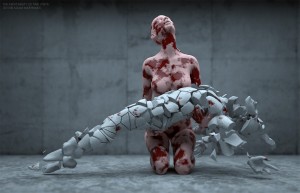Immediate Response
Upon first glance at Adam Martinakis’s piece, “Peta,” part of his collection “The Inevitability of Time,” I was awed at the extreme detail and emotion his work has. Seeing a fleshy feminine figure holding a crumbling stone figure, seemingly a man, I thought of the idea of death. Thinking about what this piece could analogize aside from death, I though broadly and came up with the idea of the frailty of the human form and the inevitable death of the human race. The raw emotion captured in the image reminded me of a funeral, as people gather to grieve over the loss of another.
Objective Description
The piece is located in what appears to be a concrete room, with a feminine flesh-toned manikin kneeling and looking skyward in despair while holding a crumbling stone looking human figure horizontally in her arms. The female’s body is proportional and emotes an atmosphere of grievance, while covered in what looks like patches of blood breaking through her skin. The figure in her arms is of a bluish-grey stone texture and is cracked and separated throughout its body, almost looking as if a statue was hit multiple times with a hammer. Furthermore, there are multiple blood colored splotches over the stone figure implying that the feminine figure was with the body at its death.
Technical Decisions
I find the construction of the work to be absolutely stunning. The placement of the figures in the center of the isolated concrete room focus the audience’s attention to the raw emotion portrayed by the feminine figure and the crumbling stone figure enhances the feeling of gloom in the piece. The use of stone texture on the deceased body draws the audience to question the cause of death, while the bloody flesh-toned figure captivates the audience with sorrowful power. Additionally, I found the material choice interesting. The fleshy-toned figure and the stone figure together in a grieving embrace symbolize the frailty of the human condition and the inevitable idea of death.
The Work in the World
I think Adam Martinakis’s piece is a pure representation of the human condition and the continuous cycle of life and death. Captured in a moment of mourning, humans can relate to the sorrow and grievance portrayed by the kneeling human figure. Additionally, noting that Martinakis’s exhibition is called “The Inevitability of Time,” it is clear he is sending a message that mankind, as a whole, must face the fact that death is imminent, and that it cannot be avoided. In comparison to other works, I find that this similarly captures the emotion of Van Gogh’s “The Scream,” which portrays a feeling of shock, grievance, and mystery through the painting’s brush stroke curvature and array of colors. I think the true beauty of Martinakis’s work lies within his ability to freeze human emotion and the idea of death in time.
The Story It Tells
The Story Adam Martinakis’s piece “Peta” tells is that of the inevitability of death throughout time. The idea of time is endless, a stark contrast to that of a human life, something that is on a timer leading towards death. The use of flesh and blood tones in the female character contrasts the cracked and deathly looking stone figure in her arms, a symbol of the frailty of human life and the sorrow death brings with it. Additionally, the concrete room in which the two figures are contained adds a feeling of captivity to the piece, which could symbolize the idea that we as humans are trapped in a world of death with no way of escaping (at least not yet).
